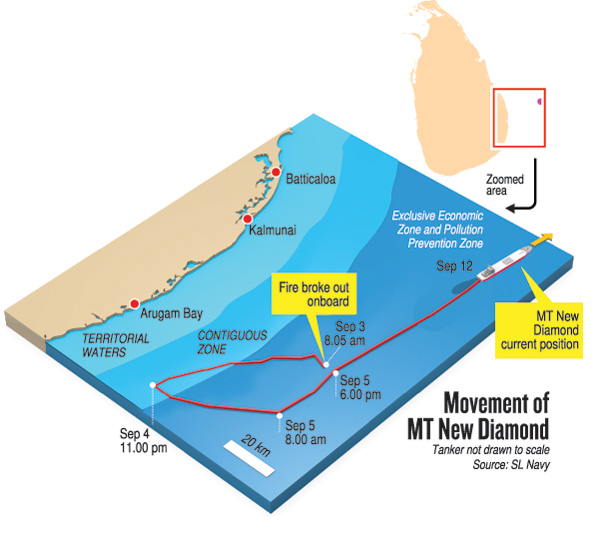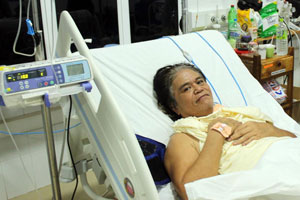News
Sri Lanka still in murky waters over MT New Diamond
- Extent of damage to environment from oil slick yet to be determined
- High level talks underway on insurance claim
- Uncertainty remains over the fate of the 270,000 metric tons of crude oil on board

The oil slick from the stricken ship. Pix courtesy SLAF
Authorities have confirmed that an oil slick from the stricken oil tanker MT New Diamond has caused some environmental damage, although the extent is yet to be determined.
As of Saturday, the oil tanker, which first caught fire on September 3, had been towed to about 45 nautical miles off Batticaloa. “The area has a 2cm thick oil layer that seems to be a mixture of engine fuel and lubricant oil,” said Marine Environment Protection Authority (MEPA) Chairperson Dharshani Lahandapura.
She added MEPA experts had approached the sea area that was within 400m of the ship to collect samples for further environmental damage analysis. Turtles and fish were spotted in the vicinity and MEPA believes that these species may have been affected too.
Marine Biologist Dr. Asha de Vos told the Sunday Times that an oil slick was problematic for a number of reasons. “They (marine life) have to surface to breathe, and if they come up through an oil slick, they can inhale the toxic substance into their lungs,” she said. They can also be exposed to crude oil substances through direct contact with skin, eyes, mouth, and blowhole(s) and they can indirectly ingest oil components directly or indirectly through their food. The absence of hair and frequent sloughing of skin means that the oil will not adhere to their bodies. She explained that the impacts are bigger for species that have restricted ranges. Many cetacean species inhabiting offshore or open coastal waters are highly mobile and range widely, so their contact with an oil spill may be relatively brief.
Experts from the salvage company hired by the ship’s owners first boarded the tanker on Wednesday (9) after the fires that were reignited by intense heat and strong winds were doused for the second time . On Friday, 17 members of the salvage team of the salvor company again boarded the tanker along with four Sri Lanka Navy personnel to conduct a damage assessment.
Nine ships from the Sri Lanka Navy, Indian Coast Guard and Indian Navy together with two Sri Lanka Coast Guard Ships and three Fast Attack Craft from the 4th Fast Attack Flotilla, as replenishment vessels and six tugs deployed by other stakeholders are actively engaged in further operations, the Sri Lanka Navy stated.
Meanwhile, aircraft from Sri Lanka Air Force (SLAF) and a Dornier aircraft of the Indian Coast Guard are doing intermittent aerial reconnaissance. SLAF aircraft have conducted more than 175 flying missions spanning over 100 flying hours during the operation to douse the fire and conduct maritime surveillance of the tanker and areas surrounding it. Some 440, 000 litres of water was used on the blazing oil tanker while 4500 kilograms of dry chemical powder was also dropped from the air to vital areas of the tanker, the SLAF stated.
High level discussions were ongoing on Friday regarding reparations for damages caused by the fire.
MEPA Chairperson Ms.Lahandapura insisted that Sri Lanka’s right to reparations would not be impacted even if the ship was tugged out to international waters. MEPA was in contact with the ship owner’s local agent, GAC shipping Ltd for discussions on the insurance claim, she added.
Coastal states like Sri Lanka have a statutory obligation to assist any ships in distress. The Sri Lankan Navy, along with the international stakeholders were able to fulfil this international obligation and save the crew and cargo of the ship. “Since we have honoured our duty as the statutory salvor we have the right to claim insurance and receive compensation,” noted Ms Lahandapura.
The contractual salvor-Boskalis Smit Singapore Pte Ltd however, was the first organisation to board the ship once the fires were doused. Three experts boarded the ship on Wednesday to conduct safety assessments and stability checks and to inspect the security of the cargo–the 270,000 metric tons of crude oil. 
Local stakeholders held opposing views on the matter of moving the tanker. The Chairman explained that the merchant community was for harbouring the ship at a Sri Lankan port; Trincomalee being the most suitable right now and using the crude oil. Ownership of cargo is automatically transferred to the first responders of a ship in distress. “However, this crude oil can’t be used by Sri Lanka because it’s different from the type we import and we don’t have the facilities or capacity to refine it for our purposes,” she countered. The only option that Sri Lanka would then have is to sell the oil.
Ms. Lahandapura said that the process of calling tenders and selling would be long and arduous. She pointed out to a lesson learned from that past as she recalled an oil spill that took place down south in 2009. Legal action took six years to conclude. During that period the entire ship collapsed and sank and the oil leaked.
Ms. Lahandanpura noted that the only possible amount of the cleanup, 60 percent, had taken four months to complete. “Compare 150 tonnes in four months with 270,000 tonnes. Our position is that compensation for expenses, environmental damage, and so on is sufficient,” she added.
The incident falls under the purview of legal instruments such as the United Nations Law of the Sea, Civil Liability Fund, Fund convention (supplementary to the Civil Liability Fund), and the Marine Pollution Prevention Act. Any potential legal action taken will encapsulate the terms dictated in these documents.
The tugging away of the ship would be the owner’s responsibility. Ms. Lahandapura noted that a ship-to-ship transfer of the crude oil, if necessary, would have to be done on international waters. “The situation would be too volatile for the Sri Lankan authorities to risk it on our waters,” she said. “However, in the event that movement of the ship with the cargo in it is deemed impossible, stakeholders of the highest authority will be brought into discussions before a careful weighed decision is reached,” she said.
A.W. Seneviratne, Director General of Merchant Shipping told the Sunday Times that officers of the vessel flag – Panama, will also arrive in Sri Lanka to conduct their own investigations and inspections of the ship. A casualty investigation will be conducted by both the officers from Panama and the Sri Lankan Authorities. This is a requirement of the International Convention for the Safety of Life at Sea, which sets out the minimum safety standards in the construction, equipment, and operation of merchant ships.
Mr. Seneviratne noted that the calculation of costs by the stakeholders involved was most likely concluded as of Friday this week. All figures will be sent to MEPA where the total figure will be entered into the insurance claim for reparations. He dismissed rumours of a refusal to the insurance claim, “there is no reason for the involved parties to deny it, the effort is visible,” he said.
Meanwhile, questions continue over Sri Lanka’s preparedness to meet an ecological disaster posed by such incidents. Coastal states such as Sri Lanka, which are located next to shipping lanes, should expect incidents like the one with MT New Diamond, said one industry expert who spoke on grounds on anonymity. “Basically, we should have been better prepared, but the agencies tasked with doing so lacked the foresight. They should have had a plan,” the source insisted.
Sri Lanka was “extremely lucky” that the fire onboard had been doused without it affecting the cargo of fuel, the expert pointed out. He referred to the incident in July this year when a Japanese oil tanker carrying 4000 metric tonnes of oil broke up into two off the coast of Mauritius, resulting in some 1000 metric tonnes of the oil leaking into the waters around the island, causing massive environmental destruction. “The destruction in Mauritius was caused by just 1000 metric tonnes of oil. MT New Diamond is carrying 270, 000 metric tonnes. Imagine the scale of the disaster if it broke up due to the fire?”
The source also expressed concern that Sri Lanka had not signed the necessary international conventions that would make it easier to obtain compensation for any environmental damage and initiate legal action against the tanker’s owners.
“There are many things that we need to do. This incident shows that these disasters could happen here, and we need to have contingency plans in place. The question is, will we learn from this and get our act together, or will we forget about it once the danger has passed.”
Another industry expert, who also wished to remain anonymous, said the incident should not discourage authorities in Sri Lanka from continuing with efforts to make Sri Lanka a maritime hub. “This is just one incident and it can happen anywhere, but planning for such emergencies will be key. It shows the need to invest in new technologies to be better prepared for them when they do happen,” he asserted.
| MEPA being strengthened, says Chairperson | |
The move to position the Marine Environment Protection Authority (MEPA) on a stronger platform was in the works when the fire aboard the MT New Diamond occurred, its chairperson told the Sunday Times.  Dharshani Lahandapura Sri Lanka’s marine zone is eight times larger than its land area, said Ms. Lahandapura, who added that MEPA’s mandate starts 300 meters from the shore and up to 200 nautical miles to the seaside. As per the Presidential Manifesto, The Vistas of Splendor, four major cities will be coming up: Colombo, Hambantota, Trincomalee, and Jaffna – all coastal areas connected to a harbour. According to the manifesto by 2025, Colombo Ms. Lahandapura also noted that around 400 ships go through Point Pedro on a daily basis and two-thirds of the world’s entire oil tanker movement crosses our borders. “There is so much untapped potential here,” she said , “oceanic resources like energy, minerals and farming potential and aquaculture and sports all point to the fact that Sri Lanka’s future is in the ocean.” Ms. Lahandapura called it a “blue economy” of sorts. With this potential as its foundation the MEPA was in the process of revamping, identifying areas for improvement and trying to strengthen the organisation starting from the act which, she said has many loopholes. “We have been discussing amendment with the legal draftsman while we have identified how to strengthen the organisation’s capacities.” This incident was an eye opener so that whatever was being discussed can be accelerated and implemented she added. MEPA acts as a regulatory body in its current capacity and lacks the resources to manage Sri Lanka’s oceanic resources. The current act only focuses on ship waste and oceanic pollution prevention which is very limiting. MEPA owned ships are also in the talks where resource expansion is concerned. Those avenues were being explored because the organisation needs to be stronger. Ms. Lahandapura admitted that MEPA has to be go from being a regulatory body to an implementing body too. Filipino engineer thankful to be a alive Elmer Egalloy, a 57-year-old Filipino engineer on board the stricken tanker said he was lucky to have been rescued by the Sri Lankan navy before an explosion took place on the vessel.
“I saw others running here and there. I did not know at that point what had really happened but I saw black smoke. He said he was on the vessel for two hours before the navy rescued him and took him to the Kalmunai hospital. He was thankful to the medical staff, from the Director down, at the Kalmunai hospital. “They are the modern day heroes in Si Lanka,” he said. “I thank God that I am alive today. He has been good to us,” he said, adding with sadness that he heard one of his colleagues had died in the explosion. Pix and text by Deva Adhiran
|


 “That morning I woke up and went for breakfast and then headed back to my cabin for a shower. It was there I heard the first explosion. I was injured,” Mr. Egalloy told the Sunday Times before he was discharged from the Kalmunai hospital this week where he was treated for injuries.
“That morning I woke up and went for breakfast and then headed back to my cabin for a shower. It was there I heard the first explosion. I was injured,” Mr. Egalloy told the Sunday Times before he was discharged from the Kalmunai hospital this week where he was treated for injuries.